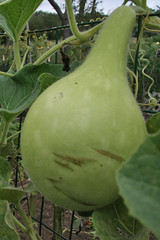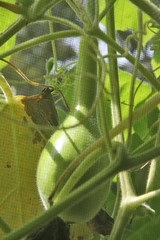I am watching four nice birdhouse gourds growing in my gardens. I’ll pick them when the stems dry and turn brown or before a frost. They’re not quite ready yet.
I looked up what to do with them and found this nice site:
Birdhouse Gourds
When dried, these gourds are nearly as tough as plywood… it may take anywhere from 3 months to a year before gourds are completely fry. After picking, set gourds on several layers of newspaper in a warm dry place. Hanging them in a sunny place works well too… don’t put any holes I the gourds at this time or they will rot.
While curing, black, white and gray mold appears. This is a natural part of the drying process…. gourds that become soft or wrinkled should be tossed…
Gourds are completely dry when the seeds rattle inside… scrub with a stainless steel pad in warm soapy water to remove mold. Drill entrance holes for cavity nesting birds, removing the seeds through the hole… Holes should be 1 ¼” for house wrens, 1 ½” for bluebirds, and 2 ½” for purple martins… Add smaller hole at the top for hanging and in the bottom for drainage.
You can custom paint each house or use wood burning tools to decorate… Consider hanging a collection of gourds together for swallows or purple martins.
Here’s a quote I found at the same site:
“When the world wearies and society fails to satisfy, There is always the garden.”
Minnie Aumonier
Decorative gourds





4 Comments. Leave new
I love your garden! I check back with your site every few days or so to get inspiration. We just bought a house with an acre in Florida. We have had it for a few months now and the first thing I did was plant a garden. The one thing that I keep asking myself about yours is, how do you keep the bugs out? I know being in a different zone (8) throws a curve ball in there but I am looking for any help I can get. Care to share your secret?
Thanks,
Tawnya
Bugs… Hmm. That’s a big question. I have stopped using any sprays because I think they cause more problems than they fix.
I use row cover and companion planting to keep the bugs out.
But like you said, it depends on your area. I have trouble with cabbage worms on kale and broccoli, so I keep these crops covered from planting until about August. I had a lot of flea beetles this year in my potatoes and so I planted lots of marigolds in with the potatoes. The flea beetles went away. Maybe the marigolds helped, maybe it was because the weather changed from dry to wet. But I do like to mix in lots of marigolds, nasturtiums and other flowers in with the vegetables.
And bird houses. I think birds can help a lot with the bugs.
Last year my fava beans got totally eaten by black aphids. I gave up and pulled the plants. This year I planted favas much earlier in the spring and in full sun and had no aphids. So I conclude that happy plants fight the bugs themselves.
Another bug I have is squash stem borers. I have tried all sorts of ways to fight these and can’t say anything seems to work for me. So my squash end up dying early because of these. This year they lasted til early Sept. Not bad. I’ll have to ask other gardeners what they do about the borers.
Hope this helps.
Geographically, I am located right about midway between the two of you. I also liberally planted marigolds and nasturtium in my garden this year and had virtually no bug problems. I was, however, decimated by powdery mildew. So sad… We were just starting to win that battle when we left for vacation. Upon returning home, well, it was not a pretty sight…
Yes, it was a really bad year for mildew and other fungi. I had terrible leaf spot – it killed my tomatoes mid summer. It was such a wet summer that it just thrived.
Some people use a fungicide for this. My dad was talking about using one next year.
I’ll try using salt marsh hay instead of plastic mulch, for better drainage. And I’ll rotate the tomatoes to the far end of my community plot in hopes fewer spores are over there. I’ll also grow more tomatoes at home. Though its shady, I have much fewer problems with diseases in my home garden.